The Coronavirus Job Retention Scheme, otherwise known as the furlough scheme, comes to an end on 30 September 2021. For business owners who can’t afford to bring staff back to work after the financial support ends, what are your options?
Bring staff back part-time
Would staff be willing to reduce their hours and pay, or even consider job sharing in order to keep their jobs and keep the business going? Any changes to your employees’ terms and conditions will need to be documented and reflected in their contracts so be sure to update paperwork and keep a paper trail of any agreements. If employee’s contracts don’t include provision for short time working any changes will need to be made with the consent of the employee.
Retraining or redeploying staff
Could employees’ skills be utilised elsewhere in the business during this period of uncertainty? This is an effective way of plugging any gaps whilst keeping retaining staff. Any changes to their contractual obligations will need to be documented and agreed by both parties.
Redundancy
Sadly this is an inevitable consequence for many businesses as the furlough scheme ends, and one which is highly documented in the press. Many employers are left with no option but to make staff redundant to keep the business afloat. If this applies to your business then read our redundancy guide to ensure you follow the correct process and don’t fall foul of employment law. Legally, you will need to enter into a consultation period which will be determined by the number of proposed redundancies. You will also need to be clear on statutory redundancy pay and associated paperwork. We can help with the process, or alternatively take a look at our redundancy guidance. It’s important to note that you can re-hire an employee after you have made them redundant if the business picks up.
Unpaid leave or sabbatical
In place of redundancy you could ask employees to take a period of unpaid leave or a sabbatical, in order to keep their role open whilst the business gets back on its feet. This is not ideal for employees, but they could consider a second / temp job during this time whilst waiting for their main job to become available again. Alternatively, you could agree to pay them on a part-time salary if they are taking a sabbatical. This may work well for any staff who have other commitments, such as young families or caring for others.
Whilst the furlough scheme has brought relief to many businesses, and employees, the next few months are undoubtedly going to hit many businesses. We are here to support with advice and guidance and will continue to produce free templates and downloads.
Receive HR updates
Sign up for our monthly newsletter.
Free HR advice
Book a 15 min call with our HR consultants.
HR Health Check
Understand how your people can help your business thrive.
